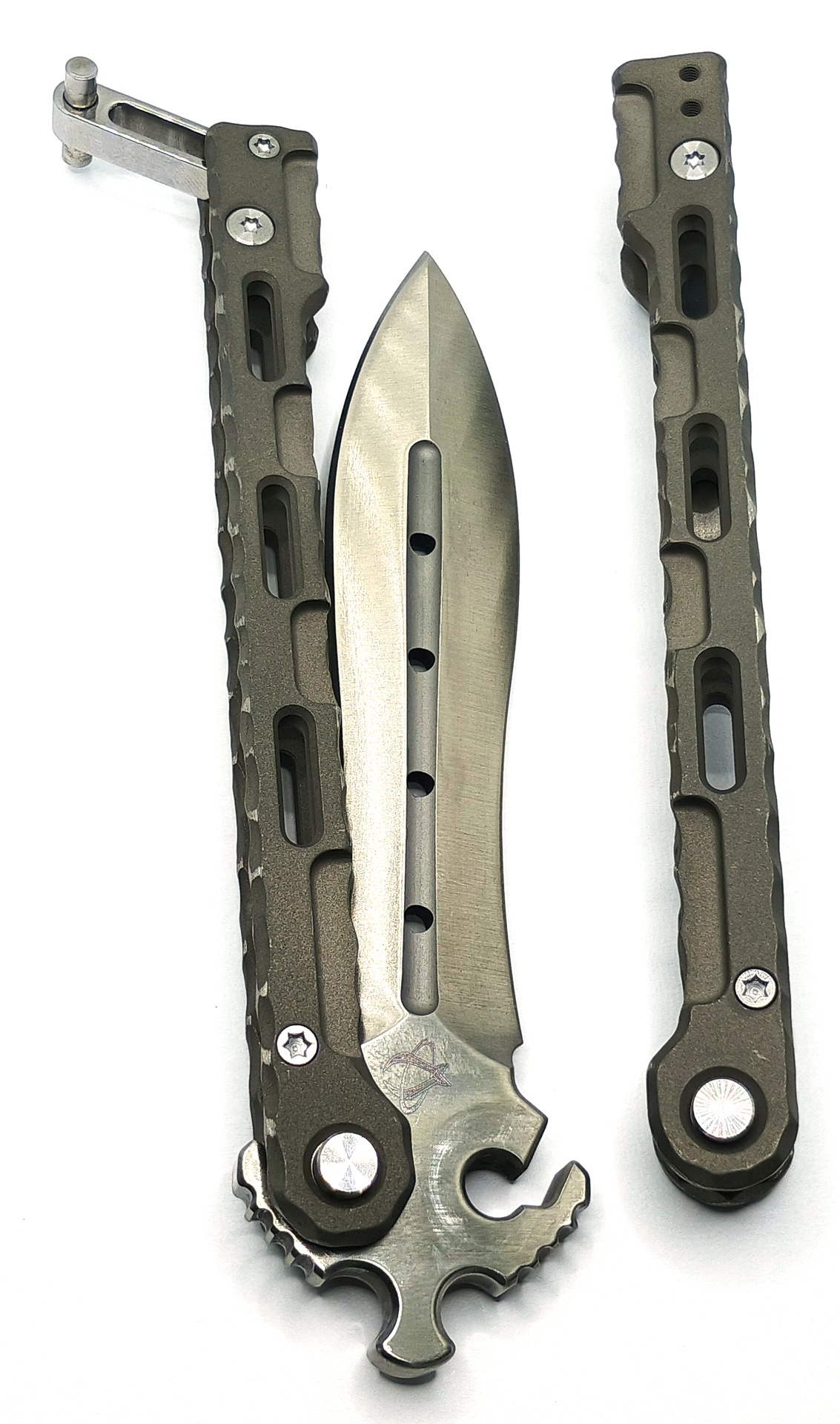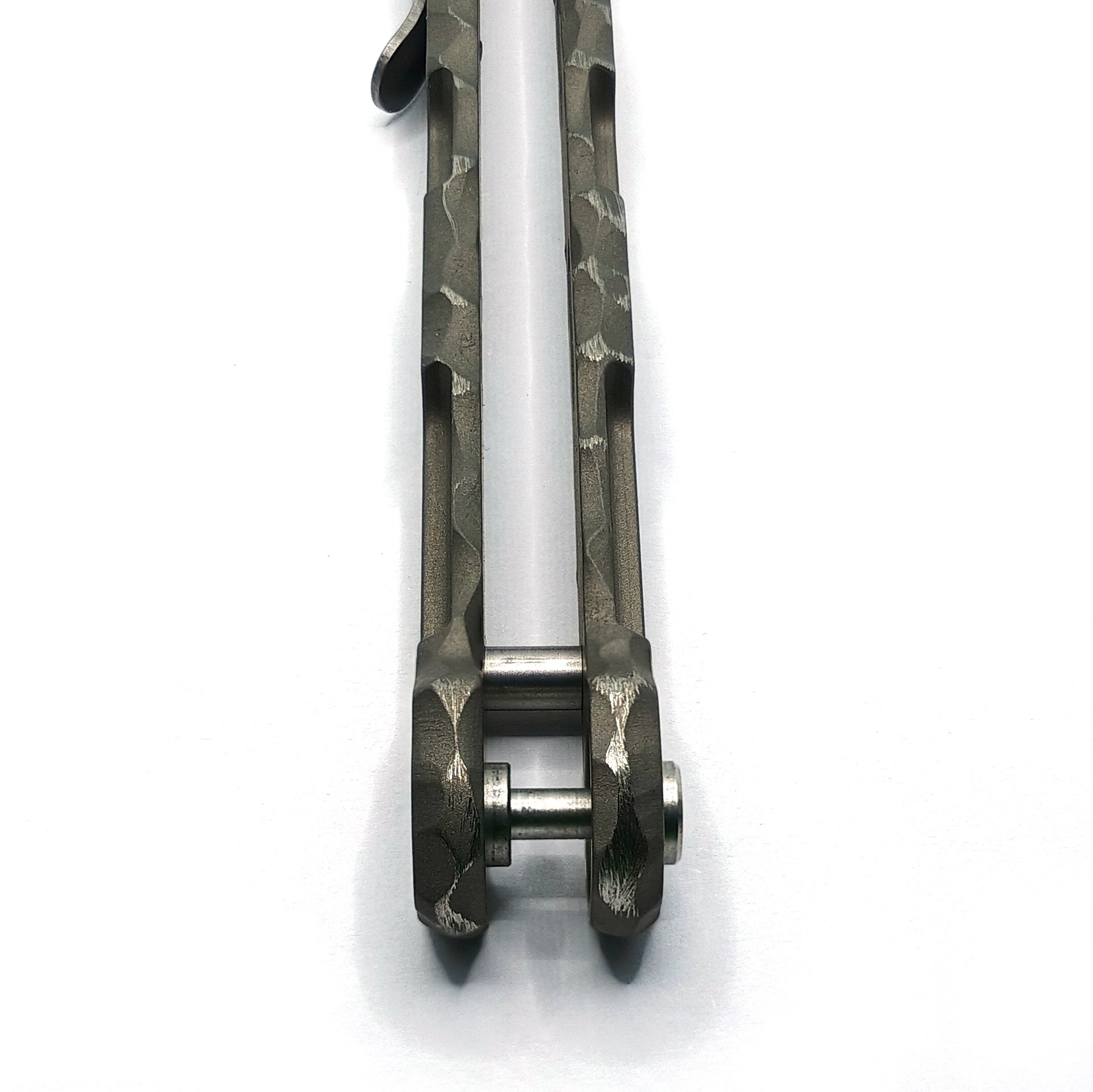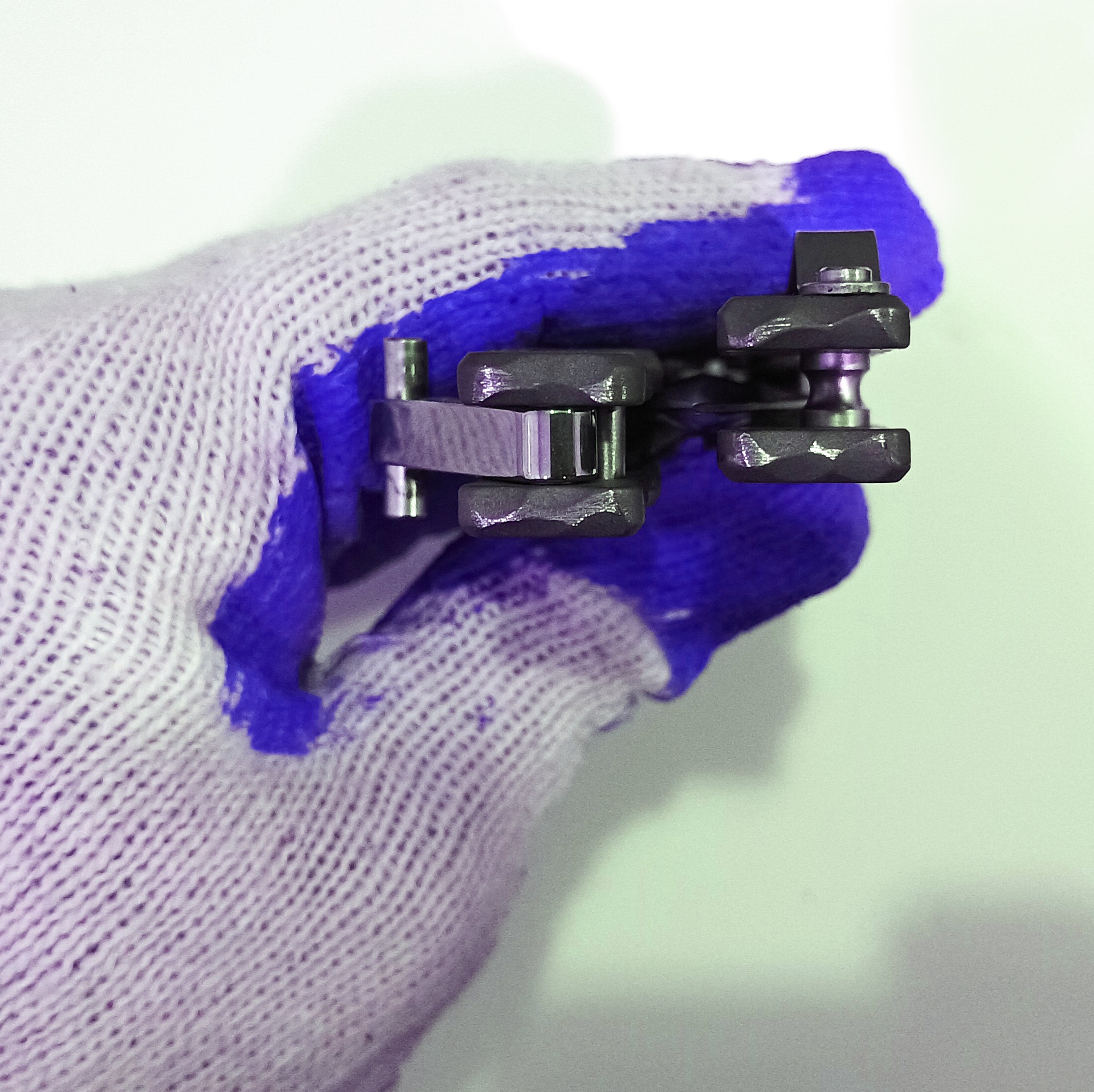“Oh, look. Another stupid balisong. Why don’t you get a new shtick, granddad?”
…

This is the Mantis Mothra. In the category of knives named after Toho movie monsters, it is probably in a class all by itself.
The Mothra is a full sized aluminum handled balisong, measuring up at 9-3/4" long when locked open, and about 5-11/16" closed. It has a 4-1/2" long spear pointed blade which is, despite its appearances, only single edged. The manufacturer calls it a “drop point” which I suppose is technically correct in the same sense that a stromboli could be called a “sandwich.”
The blade is made of 154CM and is very thick: About 7/32". That’s pretty unusual for a balisong. Not including any protuberances like the latch head or the ears of the blade sticking out the sides, the Mothra is a girthy 1-1/8" across and about 1/2" thick in total. All of this adds up to a weight of 157.5 grams or 5.55 ounces. So, ephemerality is one attribute this knife definitely hasn’t got.
(Project Farm Voice) The Mantis Mothra is made in Taiwan.

It also sports some very intense design.

The handles have this craggy, stonelike appearance on their edges that looks like it ought to be a wall texture in Quake or something. Then the blade has a deep fuller in it that’s got several holes drilled through. Suffice to say the looks are certainly unique, possibly even divisive.

The Mothra’s handles are clearly cast and not machined. If I am any judge, those blemishes down on the tail end are definitely air pockets from the casting process. The surfaces are bead blasted and anodized, so then one can only assume that all the spots on the edges and corners that’ve been rubbed through and the bare aluminum peeks through are intentional. Probably so that when the surface inevitably gets scratched or otherwise patinas, Mantis can say it’s “supposed” to look that way.
On the bright side, showing up the way it does for an MSRP (but certainly not street price) of around $300 makes me feel a lot better about the finish on that $20 Exo knockoff I was talking about a couple of weeks ago. Although, on the matter of price – hold that thought.

I’ve talked probably one too many times before about knives with “impossible” pivot screws, which present no mechanism of screwdriver engagement on their heads. This looks slick but isn’t much of a trick, of course. There’s always a flat spot on the shank of the screw or some other manner of anti-rotation feature, or failing that on a balisong specifically you can just flip it over to the side that’s got the screw heads and undo them with the knife in it’s latched position, because the tension against the shanks of the screws will hold them in place while you work. The other side always contains the screw heads.
So you see, just flip the Mothra over and…

…Oh.
Uh.
So it’s impossible to take apart, then.

Strike that, reverse it.
If you haven’t guessed, the Mothra’s trick is that it’s part of Mantis’ “BladeXchange™” series. The pivot screws are not screws; they’re buttons, which work in a manner identical to those found on a button lock folding knife. Except rather than lock and unlock the knife, they allow you to slide the blade out of the handles entirely via a channel milled into the heel of the blade that meets up with the pivot holes.

That’s visible here. And these are the easiest disassembly photos I’ve ever taken for you guys.
So the Mothra’s deal is that it’s actually incredibly easy to take apart. But why would you ever want to? Well, other than the obvious cleaning and lubrication chores…

…Mantis also sell a variety of different blade styles as you would expect, which you can replace – sorry “eXchange” – with whatever you’ve already got. One knife into many, if that’s a void that needs filling in your life. And in addition to various edge profiles they also offer a blunt trainer blade you can swap in. The one pictured there is the “Dexter” blade which has a Wharncliffe profile and loses the false edge on the back.

And the straight spine on it reveals just how ludicrously thick the blades for this thing are.

So here it is being a Dexter. Mantis seems to just name their variants based on whatever blade they come preinstalled with; insofar as I can tell, the handles are the same between their various models. So you can be like Katy Perry and change your mind; reinvent yourself (or at least your knife) as freely as you like and you’d probably have valid grounds for changing the name right along with. Swapping takes mere seconds, although the reasons for doing so are left as an exercise for the reader.
The release mechanism for the blade looks like this:

There’s a fat part and a skinny part, and a spring behind it. When you push the button the fat part sinks into the opposite side of the handle until it’s flush, and the channel in the blade is wide enough to clear the skinny part, so once you get it lined it up just slides apart.

Apropos of nothing, this also means that it is trivial to succumb to the temptation to assemble the Mothra backwards. Here it is as such. And if you do this, how it’s pictured above is as closed as it can ever get. It’s mildly amusing the first time. You probably won’t do it twice.
Anyway, the astute among you have probably already figured out two glaring asterisks hovering just above and to the right of this entire getup.
First and foremost, balisong makers go to great lengths to improve the mechanical precision of their pivots to create finer, smoother, more solid, less rattly, and generally more pleasant mechanisms for their knives. I’ve waxed poetic at great length about this sort of thing many times. Bushings, precision washers made of fancy low coefficient of friction materials like sintered bronze, ball bearings, the works. Some of this stuff costs big bucks, and balisong nerds get very excited about it.
Well, I just showed you a photo of the Mothra taken apart and it sure didn’t include any of those. That’s because it hasn’t got 'em. All the effort was apparently spent on the release mechanism and for the rest, well, we’re just banging rocks together. Literally, in fact. The pivot surfaces are just the blade steel riding directly on the inner surfaces of the handles. The bead blasted and textured aluminum oxide anodized surfaces of the handles. You know, that stuff they make sandpaper out of? So you’d predict that it scuffs up the pivot area something fierce.

And you’d be right. Give that reader a cigar. No washers, no nothing. Not even a pair of perfunctory plastic ones.
The other part is, all of this needs to have a generous clearance so that you can actually slide the pieces apart without them getting all jammed up. So with no bearings or bushings in there either, this thing must rattle like a telegraph office.

Right again.
I will hasten to point out that the pivot play on this knife is so bad that if you look carefully, you can see that the only thing stopping it from getting even more off-axis is the fact that it’s stopped by the inner face of one of the handles hitting the flat of the blade. Oof.
(I hue shifted that photo, by the way, because the gripper-stuff on those gloves I was wearing happens to be red and I just know the types of comments that would garner. The original, unaltered photo is here, you weirdos.)
You absolutely cannot tune this knife. Not in any way, shape, or form. There is no screw tension to adjust, no washers to swap, no bushings to shave. It is what it is, now and forever. And part of the problem is that the “pins,” for lack of a better word, that make up the pivot and release mechanism don’t even engage with the holes in the blade all the way through. The solid part only rises up a little less than halfway through the thickness of the blade so the top half is always left freely floating and able to wiggle around.
Mantis probably could have cured that by making the blade a little thinner. But they didn’t. And lo, here we are.
So that leaves the question of the Mothra’s balisong action hanging in air. Like a particular metaphor. One that I’m not going to make.
The answer is that it’s distinctly weird. The enormous rattle and play in the blade notwithstanding – that doesn’t actually impact the moment-to-moment usage any. The Mothra’s rebound action is also pretty okay, probably owing to its trendy but now common “zen” pin design which locates the rebound pins inside the handles rather than having them press fit through the blade. But other than that, since we’re on the topic, there are no other fancy features. No spring latch, no weights, no interchangeable scales. Heck, no scales at all.

The Mothra’s downfall is presented in two acts. Neither of them, surprisingly are the weird handle texture. And rest assured, it is weird, but you can get used to that sort of thing easily enough. No, but there’s another uncanny feeling to its action that’s tough to put you finger on until you really think about it. Eventually you’ll realize that it’s caused by the blade (64.6 grams) weighting significantly more than the handles (44.5 grams each) which is the opposite of most balisongs.
Beyond its pivot mechanism, a balisong knife’s flipping feel is normally pretty much exclusively generated by its handles, which should weigh the same or more as the blade and often they have thin blades that are carefully tuned to achieve this effect. Not so with the Mothra, though. As previously noted, its blade(s) are enormous, thick, and very heavy. So that leaves the point of balance not in the handles or even hanging around the pivot point but swinging around wildly somewhere out in space. And because of that, where it is also changes relative to where in its arc the blade happens to be at any given moment.
This causes the Mothra to feel a lot less like a competition balisong and a lot more like a medieval flail. Its spins are by necessity long and slow, and if you try to apply any kind of speed to any trick and break concentration even for a split second it will positively leap out of your hand and away, seemingly of its own accord. Again, this could have been remedied by a thinner blade. Indeed, the monstrously fat blade is cool and all just in and of itself, but if Mantis wanted to do something like that’d it’d probably have been a better idea to put it on an ordinary folder or something and not their flagship balisong. Just saying.

And here’s the other thing. Have you spotted it?
The Mothra’s clip is in the wrong place.
No, I don’t mean on the wrong side of its handle because my objectively correct opinion is to prefer it to be rearward towards your pocket seam when clipped and I always complain about that, nerrr. No, it’s on the fucking safe handle. The one you hold, and have to spin and roll over in your hand when you’re manipulating the knife. That’s not where it goes. There’s a reason it always goes on the bite handle, at least on other knives, and also why that’s the side with the latch. But here it isn’t, and there are no mounting holes on that handle so it can’t be put there. So it’s in the way. Always. And it’s massively disconcerting.
The only cure for that is to just take it off.
Okay, yes, there’s nothing stopping you from just popping the knife apart and flipping the blade over so the edge slots into the other handle instead. But now the latch is on what has become the safe handle, and that absolutely will come back to bite you (literally) if do that and then switch between this and a different knife.
I have no idea why this is. Do you hear me, Mantis? Fix it. Put the stupid holes on the other handle. There’s plenty of room for them there; it’ll be easy.
So yeah. It looks cool, it definitely has a gimmick, but it’s all talk and nothing in the sack.

Look, here’s the Mothra with a pair of other full sized balis. That’s a Kershaw Moonsault on the left, and a Benchmade 42 on the right. The Mothra’s about the width of a Moonsault (although it’s thinner in profile), but about the same length as the Model 42. Monkey in the middle, there you go.
The Inevitable Conclusion
The entire Mantis BladeXchange series is one of those situations where there’s a solution desperately in search of a problem. I mean, sure, you can theoretically use this to arrange your life so that your trainer balisong and your real balisong are the same knife. But so many compromises and sacrifices need to be made to get there that you have to ultimately ask yourself, is it worth it? A nice live balisong can be had for $200 (or a lot less), and trainer versions of various knives even from major manufacturers are basically free by comparison. I’m feeling like a two-knife solution is probably a better strategy overall.
That brings us back to that point I stuck a pin in earlier, actually. Riddle me this:
Where, precisely, is the value found in a balisong knife?
I mean, physically, not philosophically. Dollars and cents. What part of it makes it cost what it costs, $40 or $100 or $300 or whatever it is? Half of the world will say it is in the mechanicals: in the precision machine work, the design, the pivot mechanism, tuning the balance, and all of those tactile but ultimately conceptual things that take time and care to get right. That’s why a flea market knife costs $20 and is crap, and why a Benchmade costs $300 and it isn’t. Right?
The other half of the world will say it’s obviously in the blade, dummy, with whatever fancy alloy steel it is plus all that heat treating and cryo quenching and sharpening and polish work. Which is clearly why, say, a live blade Flytanium FlyOne costs $500 but a Flytanium Zenith trainer is only $60. You dig?
Well, a whole Mothra costs you $180 real world dollars or so, but you can buy its blade loose for $35. And there ain’t much precision machine work in the handles, which is all that’s left over. Hell, they’re even cast to reduce cost, and not very well at that. And as we saw there isn’t a single washer, bushing, or bearing in the entire damn assemblage. Somehow here, one plus one comes out equaling five.
So where, exactly, is fancy bred? Is it in the heart, or in the head?



Why single-edge? I just can’t get over that.
You ever use a double edged balisong? It’s not the sort of thing you just want to be handing out to people like candy.
I have, and absolutely was bit by muscle memory!